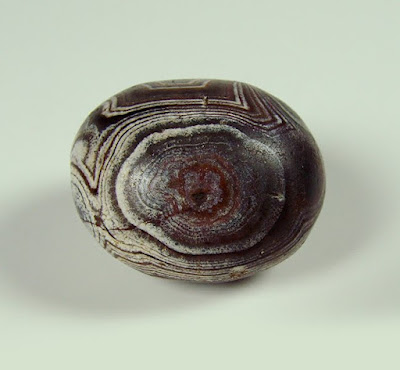Thursday, December 09, 2010
An ancient agate eye bead (convex shape on both sides). Western Asiatic. This bead has no noticeable crystalline banding that forms an eye, nor has it been decorated with an eye design. So in this case it is the shape of the bead that indicates it as being an eye amulet. James Lankton places a similar bead (no.208) on his timeline and dates it to around 4000 BCE. 30 mm x 25 mm x 10 mm
Monday, November 29, 2010
Imitation Sakor Namkor sourced in North India (2010). 39.07 mm x 13.91.
Above: A small ancient decorated carnelian (12 mm x 5 mm)
with a pinkish white body and dark lines.
The colour is probably the
result of fire damage.
result of fire damage.
We do see ancient white stone beads with dark lines, however, most have probably been damaged by excessive heat at the time of being made or as a result of a funeral pyre. Sometimes this appearance is attributed to beads being buried for long periods but this is still unproven. Ancient decorated carnelians (also known as etched carnelians) will sometimes display a white body with black lines (Beck classifies this as Type II). It is unlikely that this was the intention of the bead maker because the overall result is usually quite crude. Ancient dZi beads that display crystalline areas or translucent banding on the body, are a clear testament to colour treatments not being able to take to the crystalline areas--and so this is why we do not see ancient dZi beads made purely from this material.
Saturday, September 04, 2010
A Tibetan woman (1930s) wears a necklace comprised of ancient dZi, banded agates (also known as Bhaisajyaguru dZi), coral and a large amulet or gau box. Gaus with the 'two intersecting squares' design were apparently very fashionable in Lhasa from "at least the middle of the 19th century". According to John Clarke (Victoria and Albert Museum Curator) this symbolises two crossed dorjes or a double vajra. They can often be made from silver or gold and can be inlaid with a variety of semi-precious stones, more commonly with coral and turquoise. These days similar gaus may even contain precious stones like rubies and diamonds and display a chosen deity on the front. The gau might contain a wealth of sacred items that have been blessed by revered Lamas. They might also contain relics, mantras, a small statue or Tsa Tsa and are regarded as one of the most important family heirloom pieces.
Friday, August 27, 2010
A lovely tabular agate eye bead from Great Britain. It was aquired from the famous Keith Mitchell gem collection, and is believed to be from the Georgian era (1714 to 1830). Agate eye beads and pendants were once popular in the UK, probably reaching their peak in jewellery use during the Victorian period. An agate brooch (commonly set with a 'bulls eye' agate) were particularly favoured in Victorian times. 38 mm x 27 mm x 12 mm.
Thursday, August 26, 2010
Monday, August 02, 2010
Monday, July 05, 2010
Friday, June 18, 2010
Reinhold Messner is seen here wearing a two eyed dZi bead flanked with red coral. This is the typical way a man would wear a dZi bead in the Himalayan regions. Messner says he obtained his bead in Tingri in 1981 and it always fascinates the Sherpas and Tibetans when they see him wearing it. He is regarded by some as the greatest mountain climber of all time. In the 1970s he was the first to reach the summit of Everest without bottled oxygen. Following that he was the first to achieve a solo Everest climb. In 2004 he completed a 2000 kilometer expedition through the Gobi desert. The list goes on!
Thursday, June 10, 2010
A stunning ancient bicone jasper disc bead. 46.77 mm (diameter) x 14.62 (depth). It always amazes me how jasper is often overlooked in favour of banded agate beads. Jasper is an opaque form of chalcedony and the name is likely to have originated from the Persian word "yašp". Jasper is certainly amongst the most colourful materials used in antiquity. According to the second book of the Hebrew bible (Exodus), it was also used in the breastplate of Jewish high priests. This bead was supposedly found in the Western Sahara desert and was possibly a spindle whorl.
Friday, May 28, 2010
Subscribe to:
Comments (Atom)




















































